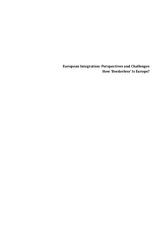Discovering Europe? Identity of the Migrants in the EU
Аутори
Fiket, Irena
Di Mauro, Danilo
Остала ауторства
Tarrósy, IstvánTuka, Ágnes
Vörös, Zoltán
Schmidt, Andrea
Поглавље у монографији (Објављена верзија)
Метаподаци
Приказ свих података о документуАпстракт
This paper focuses on migration in Europe and European identity. Above all, it aims
to explore the capacity of European identity to offer an inclusive form of collective affiliation
both for intra- and extra-European migrants. We argue that the probability
for both, extra- and intra-EU migrants, to develop European identity is higher than
the probability to develop country-of-residence identity since the later one is based
on ascriptive criteria and therefore exclusive in its nature. Social scientists from different
traditions started only recently to deal with those questions focusing, above
all, on the effects of mobility within EU borders on identity and attitudes towards
Europe (Favel, 2009; Recchi and Favel, 2009). Our research aims to contribute to this
theoretical and empirical debate by analysing also extra-European migrants. The
high magnitude of extra-EU immigration (more than 30 million, out of the total 47
million of migrants that reside in EU countries were born... outside the EU according to
Eurostat 2011) clearly shows the importance of the relationship between migrants
and European identity. In our empirical analyses we will rely on 2009 Eurobarometer
(EB) and 2009 European Election Survey (EES) data
Кључне речи:
european identity / migrants / EU / cosmopolitan EuropeИзвор:
European Integration: Perspectives and Challenges. How ‘Borderless’ is Europe?, 2014, 121-133Издавач:
- Budapest : IDResearch Ltd./Publikon Publishers
URI
http://jmonnet.btk.pte.hu/wp-content/uploads/2014/08/jm_2014_vfinalfinal.pdfhttp://rifdt.instifdt.bg.ac.rs/123456789/1729
Колекције
Институција/група
IFDTTY - CHAP AU - Fiket, Irena AU - Di Mauro, Danilo PY - 2014 UR - http://jmonnet.btk.pte.hu/wp-content/uploads/2014/08/jm_2014_vfinalfinal.pdf UR - http://rifdt.instifdt.bg.ac.rs/123456789/1729 AB - This paper focuses on migration in Europe and European identity. Above all, it aims to explore the capacity of European identity to offer an inclusive form of collective affiliation both for intra- and extra-European migrants. We argue that the probability for both, extra- and intra-EU migrants, to develop European identity is higher than the probability to develop country-of-residence identity since the later one is based on ascriptive criteria and therefore exclusive in its nature. Social scientists from different traditions started only recently to deal with those questions focusing, above all, on the effects of mobility within EU borders on identity and attitudes towards Europe (Favel, 2009; Recchi and Favel, 2009). Our research aims to contribute to this theoretical and empirical debate by analysing also extra-European migrants. The high magnitude of extra-EU immigration (more than 30 million, out of the total 47 million of migrants that reside in EU countries were born outside the EU according to Eurostat 2011) clearly shows the importance of the relationship between migrants and European identity. In our empirical analyses we will rely on 2009 Eurobarometer (EB) and 2009 European Election Survey (EES) data PB - Budapest : IDResearch Ltd./Publikon Publishers T2 - European Integration: Perspectives and Challenges. How ‘Borderless’ is Europe? T1 - Discovering Europe? Identity of the Migrants in the EU SP - 121 EP - 133 UR - https://hdl.handle.net/21.15107/rcub_rifdt_1729 ER -
@inbook{
author = "Fiket, Irena and Di Mauro, Danilo",
year = "2014",
abstract = "This paper focuses on migration in Europe and European identity. Above all, it aims
to explore the capacity of European identity to offer an inclusive form of collective affiliation
both for intra- and extra-European migrants. We argue that the probability
for both, extra- and intra-EU migrants, to develop European identity is higher than
the probability to develop country-of-residence identity since the later one is based
on ascriptive criteria and therefore exclusive in its nature. Social scientists from different
traditions started only recently to deal with those questions focusing, above
all, on the effects of mobility within EU borders on identity and attitudes towards
Europe (Favel, 2009; Recchi and Favel, 2009). Our research aims to contribute to this
theoretical and empirical debate by analysing also extra-European migrants. The
high magnitude of extra-EU immigration (more than 30 million, out of the total 47
million of migrants that reside in EU countries were born outside the EU according to
Eurostat 2011) clearly shows the importance of the relationship between migrants
and European identity. In our empirical analyses we will rely on 2009 Eurobarometer
(EB) and 2009 European Election Survey (EES) data",
publisher = "Budapest : IDResearch Ltd./Publikon Publishers",
journal = "European Integration: Perspectives and Challenges. How ‘Borderless’ is Europe?",
booktitle = "Discovering Europe? Identity of the Migrants in the EU",
pages = "121-133",
url = "https://hdl.handle.net/21.15107/rcub_rifdt_1729"
}
Fiket, I.,& Di Mauro, D.. (2014). Discovering Europe? Identity of the Migrants in the EU. in European Integration: Perspectives and Challenges. How ‘Borderless’ is Europe? Budapest : IDResearch Ltd./Publikon Publishers., 121-133. https://hdl.handle.net/21.15107/rcub_rifdt_1729
Fiket I, Di Mauro D. Discovering Europe? Identity of the Migrants in the EU. in European Integration: Perspectives and Challenges. How ‘Borderless’ is Europe?. 2014;:121-133. https://hdl.handle.net/21.15107/rcub_rifdt_1729 .
Fiket, Irena, Di Mauro, Danilo, "Discovering Europe? Identity of the Migrants in the EU" in European Integration: Perspectives and Challenges. How ‘Borderless’ is Europe? (2014):121-133, https://hdl.handle.net/21.15107/rcub_rifdt_1729 .


